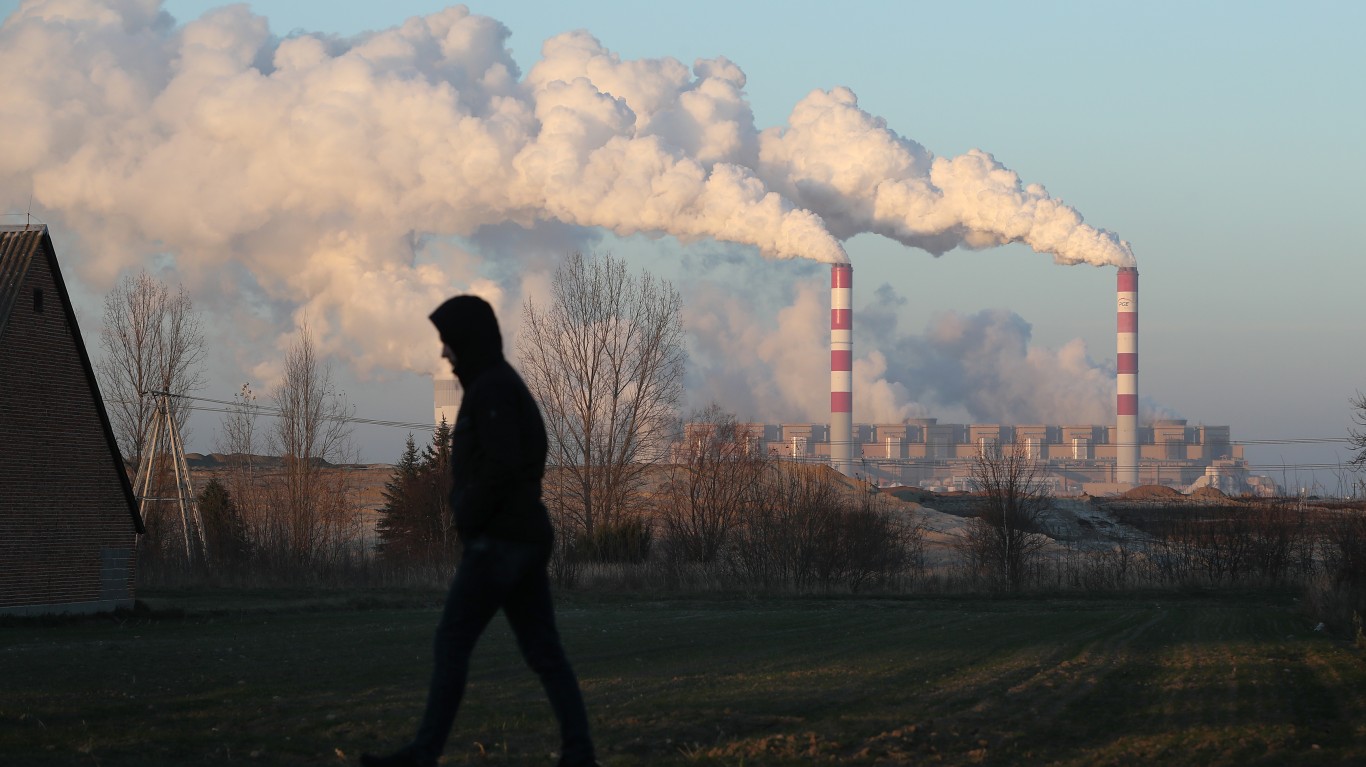
The Paris Agreement in 2015 was an historic accord that committed nations on every continent to reducing greenhouse-gas emissions. The goal was to limit the rise in mean global temperature to less than a 2ºC (3.6ºF) – and preferably no more than a 1.5ºC (2.7ºF) – differential over pre-industrial levels. The agreement operates on a five-year cycle and during that time nations take action to reduce their carbon emissions. In 2020, the signatory countries submitted plans for climate action called nationally determined contributions (NDCs).
Even as nations endeavor to shift to renewables and away from oil, coal, and natural gas, however, they still require fossil fuels to operate their economies. And some remain the biggest producers of CO2 in the world.
To determine the 50 countries with the world’s highest CO2 emissions per capita in 2019, 24/7 Wall St. reviewed data for some 148 countries from the International Energy Agency’s GHG Emissions from Energy 2021 Edition report. Countries are ranked by CO2 emissions in metric tons per population. Data on CO2 emissions in 2010 is also given in metric tons per population. Data on CO2 emission per GDP is given in kg of CO2 per GDP in 2015 U.S. dollars, and data on total greenhouse gas emissions from energy is given in million metric tons of the CO2 equivalent. All data comes from the IEA.
European and Asian countries dominate the list, although nations from every continent except Antarctica are represented. Even Western European nations such as The Netherlands and Norway that are considered leaders in the move toward a sustainable future, are still using fossil fuels, so have found a place here. (These are the 40 countries that are decreasing emissions the fastest.)
Eastern European countries striving to recover from the legacy of the command economies that stifled economic progress during the communist era are using dirty energy sources such as coal to build their economies. Their environments are among the most polluted in Europe because of smoke-belching factories and older, less-efficient vehicles powered by diesel fuel. (Here are 26 countries that consume more energy than they produce.)
Click here to see the 50 countries with the highest CO2 emissions per capita
In Asia, nations on the Arabian Peninsula such as Qatar and Bahrain, among the richest countries in the world per capita, are also among the highest in CO2 emissions because their economies are based on the drilling and distribution of oil. Four of the five countries with the highest CO2 emissions per capita are on the Arabian Peninsula.

50. Suriname
> CO2 emissions, metric tons per capita, 2019: 4.54
> CO2 emissions, metric tons per capita, 2010: 3.27 — #71 lowest of 147 countries
> CO2 emissions per GDP, 2019: 0.30 — #33 highest of 148 countries
> Total GHG emissions, million metric tons, 2019: No data
The South American country’s intended nationally determined contribution to the 2015 Paris Agreement committed Suriname to improve forest management and augment its carbon-sink potential. There are no greenhouse-gas emissions targets for 2030, however, for this nation of about 600,000 people.
[in-text-ad]

49. United Kingdom
> CO2 emissions, metric tons per capita, 2020: 4.56
> CO2 emissions, metric tons per capita, 2010: 7.59 — #38 highest of 147 countries
> CO2 emissions per GDP, 2020: 0.12 — #40 lowest of 148 countries
> Total GHG emissions, million metric tons, 2020: 317.52 — #16 highest of 87 countries
The nation of more than 67 million people aims for a total decarbonization goal by 2050 and intends to slash greenhouse-gas emissions by 68% by 2030 from 1990 levels. Total CO2 emissions have plunged more than 44% since 1990.
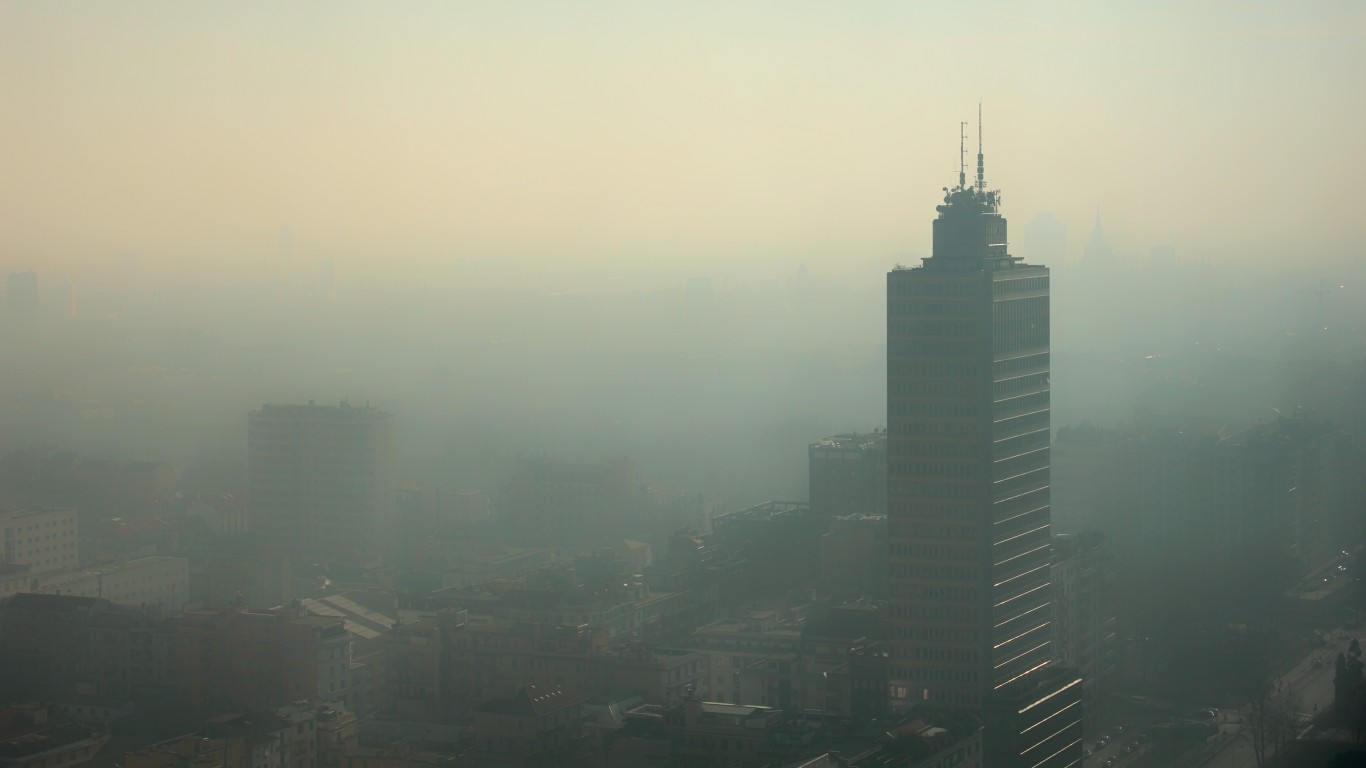
48. Italy
> CO2 emissions, metric tons per capita, 2020: 4.67
> CO2 emissions, metric tons per capita, 2010: 6.55 — #43 highest of 147 countries
> CO2 emissions per GDP, 2020: 0.13 — #51 lowest of 148 countries
> Total GHG emissions, million metric tons, 2020: 290.53 — #18 highest of 87 countries
Italy, which produced the 18th-highest level of total greenhouse-gas emissions in 2020, has an aggressive plan to decarbonize. The nation of 60 million people aims to achieve 30% in renewables in total energy consumption by 2030 and 55% in electricity generation.
47. Hong Kong
> CO2 emissions, metric tons per capita, 2020: 4.70
> CO2 emissions, metric tons per capita, 2010: 5.90 — #50 highest of 147 countries
> CO2 emissions per GDP, 2020: 0.09 — #17 lowest of 148 countries
> Total GHG emissions, million metric tons, 2019: No data
This so-called Special Administrative Region of China derives all its electricity from fossil fuels. Air pollution from rapid urbanization in Hong Kong, with a population of 7.5 million, is a major issue.
[in-text-ad-2]
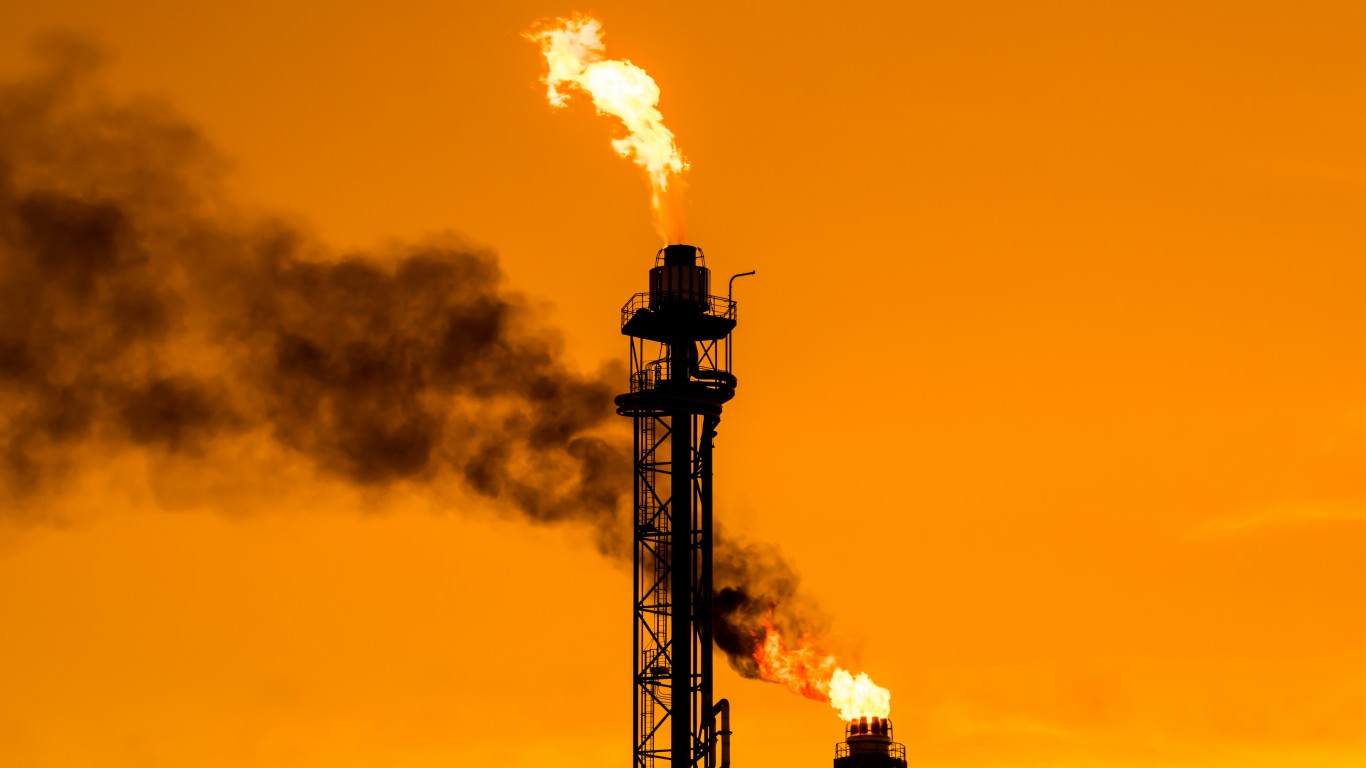
46. Slovak Republic
> CO2 emissions, metric tons per capita, 2020: 4.85
> CO2 emissions, metric tons per capita, 2010: 6.37 — #44 highest of 147 countries
> CO2 emissions per GDP, 2020: 0.15 — #63 lowest of 148 countries
> Total GHG emissions, million metric tons, 2019: No data
This Central European nation’s energy policy aims to make deployment of energy more efficient, reducing energy intensity and expanding its nuclear power sector. Energy utilization in the nation of 5.5 million can be unpredictable and government tariffs on energy use makes it expensive.

45. Bulgaria
> CO2 emissions, metric tons per capita, 2020: 4.96
> CO2 emissions, metric tons per capita, 2010: 5.94 — #49 highest of 147 countries
> CO2 emissions per GDP, 2020: 0.24 — #46 highest of 148 countries
> Total GHG emissions, million metric tons, 2019: No data
Bulgaria was in the top third of nations generating CO2 emissions per GDP in 2020. Air pollution is a big concern in the nation of nearly 7 million people, as it is in most nations in Eastern Europe. Renewable energy accounts for 19% of Bulgaria’s energy usage.
[in-text-ad]
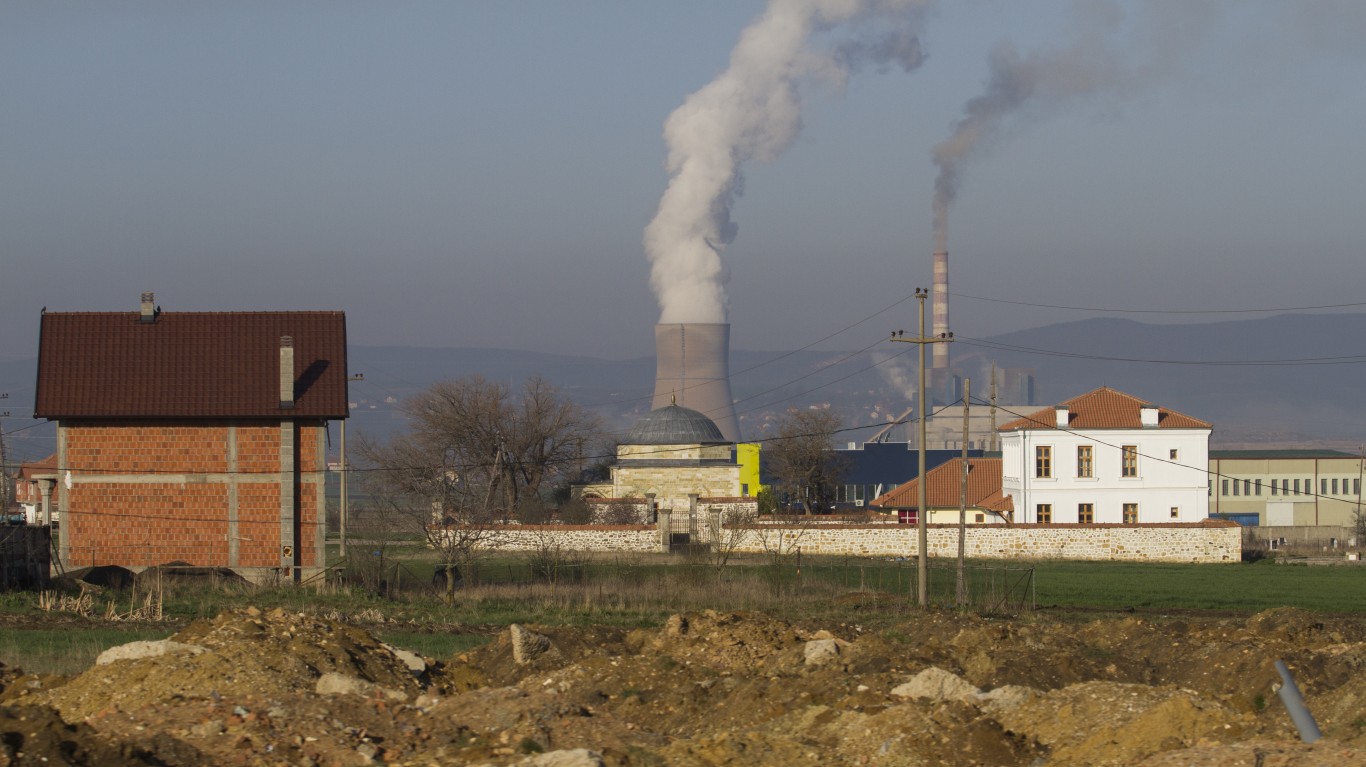
44. Kosovo
> CO2 emissions, metric tons per capita, 2020: 4.98
> CO2 emissions, metric tons per capita, 2010: 4.91 — #60 highest of 147 countries
> CO2 emissions per GDP, 2020: 0.47 — #13 highest of 148 countries
> Total GHG emissions, million metric tons, 2019: No data
This Balkan nation of 1.8 million had the 13th-highest level of CO2 emissions per GDP in 2020. Fossil fuels account for 97% of Kosovo’s electricity usage. Air pollution from power plants and lignite mines hurt the nation’s health.

43. Belarus
> CO2 emissions, metric tons per capita, 2020: 5.89
> CO2 emissions, metric tons per capita, 2010: 6.27 — #46 highest of 147 countries
> CO2 emissions per GDP, 2020: 0.31 — #29 highest of 148 countries
> Total GHG emissions, million metric tons, 2019: No data
A landlocked neighbor to Russia, Belarus was in the top fifth of countries generating CO2 emissions per GDP in 2020. The nation of 9.4 million is trying to diversify its energy mix, developing nuclear power and moving away from natural-gas consumption. Fossil fuels account for 96% of its electricity use.

42. Serbia
> CO2 emissions, metric tons per capita, 2020: 6.26
> CO2 emissions, metric tons per capita, 2010: 6.32 — #45 highest of 147 countries
> CO2 emissions per GDP, 2020: 0.36 — #22 highest of 148 countries
> Total GHG emissions, million metric tons, 2019: No data
This Balkan nation of 6.9 million was in the top sixth of all countries generating CO2 emissions per GDP in 2020. Serbia has a plan to shift to renewable energy sources. Air pollution is a major problem in cities such as Belgrade. Fossil fuels account for 65% of the nation’s energy needs.
[in-text-ad-2]

41. Israel
> CO2 emissions, metric tons per capita, 2020: 6.29
> CO2 emissions, metric tons per capita, 2010: 8.98 — #26 highest of 147 countries
> CO2 emissions per GDP, 2020: 0.17 — #72 highest of 148 countries
> Total GHG emissions, million metric tons, 2020: 59.34 — #43 lowest of 87 countries
Israel aimed to have 10% of its electricity generated from renewable energy in 2020. Solar thermal and photovoltaic power plants were forecast to generate 70% of total energy production for the nation of 9.2 million.

40. Ireland
> CO2 emissions, metric tons per capita, 2020: 6.35
> CO2 emissions, metric tons per capita, 2010: 8.57 — #29 highest of 147 countries
> CO2 emissions per GDP, 2020: 0.07 — #9 lowest of 148 countries
> Total GHG emissions, million metric tons, 2019: No data
Ireland was able to recover from the 2008 economic crisis and limited its carbon footprint in the process. This was achieved partly through its elevated use of wind power. Ireland has the second-highest share of wind in electricity generation of any International Energy Agency member. The island republic of 5 million people also has reduced its use of oil. Because Ireland is becoming a desirable place for data hosting, electricity needs will increase, possibly setting back decarbonization efforts.
[in-text-ad]

39. Bosnia and Herzegovina
> CO2 emissions, metric tons per capita, 2020: 6.42
> CO2 emissions, metric tons per capita, 2010: 5.53 — #54 highest of 147 countries
> CO2 emissions per GDP, 2020: 0.48 — #12 highest of 148 countries
> Total GHG emissions, million metric tons, 2019: No data
Bosnia and Herzegovina had the 12th-highest level of CO2 emissions per GDP in 2020. The Balkan country of 3.3 million is working to diversify its energy needs through solar, wind, hydro, and geothermal. Electricity is supplied equally by fossil fuels and hydroelectric plants.

38. Austria
> CO2 emissions, metric tons per capita, 2020: 6.42
> CO2 emissions, metric tons per capita, 2010: 8.17 — #35 highest of 147 countries
> CO2 emissions per GDP, 2020: 0.13 — #49 lowest of 148 countries
> Total GHG emissions, million metric tons, 2019: No data
Austria was in the top third of nations producing CO2 emissions per GDP in 2020. Its government is targeting 2040 to reach carbon neutrality. The country of 8.9 million people had reached 77% renewables share of electricity by 2018.

37. Finland
> CO2 emissions, metric tons per capita, 2020: 6.46
> CO2 emissions, metric tons per capita, 2010: 11.56 — #17 highest of 147 countries
> CO2 emissions per GDP, 2020: 0.14 — #58 lowest of 148 countries
> Total GHG emissions, million metric tons, 2019: No data
Finland, among the 20 highest generators of CO2 emissions metric tons per capita in 2010, has ambitious plans to reach net-zero carbon emissions by 2035. The Nordic nation of 5.5 million is targeting transportation and industry to reduce carbon emissions. Finland also is a world leader in second-generation biofuels.
[in-text-ad-2]

36. Estonia
> CO2 emissions, metric tons per capita, 2020: 6.47
> CO2 emissions, metric tons per capita, 2010: 14.02 — #13 highest of 147 countries
> CO2 emissions per GDP, 2020: 0.19 — #64 highest of 148 countries
> Total GHG emissions, million metric tons, 2020: 9.14 — #13 lowest of 87 countries
Estonia is rich in oil shale, giving the Baltic nation energy independence. However, use of this energy source has made the country of 1.3 million among the most carbon-intensive countries in Europe. The government is shifting away from shale and aims to stop producing shale oil in 2035, with a goal of carbon neutrality by 2050.

35. New Zealand
> CO2 emissions, metric tons per capita, 2020: 6.48
> CO2 emissions, metric tons per capita, 2010: 6.97 — #40 highest of 147 countries
> CO2 emissions per GDP, 2020: 0.17 — #71 lowest of 148 countries
> Total GHG emissions, million metric tons, 2020: 34.76 — #36 lowest of 87 countries
New Zealand, in the top half of countries in total greenhouse-gas emissions in 2020, is considered an example of a nation making progress toward carbon neutrality, which it aims to attain by 2050. The country of 5.1 million is employing hydropower and geothermal energy. New Zealand is phasing out production of offshore oil and gas.
[in-text-ad]

34. Norway
> CO2 emissions, metric tons per capita, 2020: 6.71
> CO2 emissions, metric tons per capita, 2010: 8.18 — #34 highest of 147 countries
> CO2 emissions per GDP, 2020: 0.11 — #35 lowest of 148 countries
> Total GHG emissions, million metric tons, 2020: 37.96 — #38 lowest of 87 countries
Norway, one of the world’s largest energy exporters, is one of the world’s staunchest advocates for renewable energy sources. The Nordic nation of 5.4 million has decarbonized much of its economy but still needs to reduce carbon in transportation and industry. It has set a goal of 2030 to cut greenhouse-gas emissions by 40%.

33. Cyprus
> CO2 emissions, metric tons per capita, 2020: 6.75
> CO2 emissions, metric tons per capita, 2010: 8.97 — #27 highest of 147 countries
> CO2 emissions per GDP, 2020: 0.19 — #66 highest of 148 countries
> Total GHG emissions, million metric tons, 2019: No data
This Eastern Mediterranean island nation of 900,000 people was in the top half of countries producing CO2 emissions in 2010. Cyprus created a fund earlier this decade to promote renewable energy and energy efficiency. Fossil fuels provide 85% of the country’s energy needs.
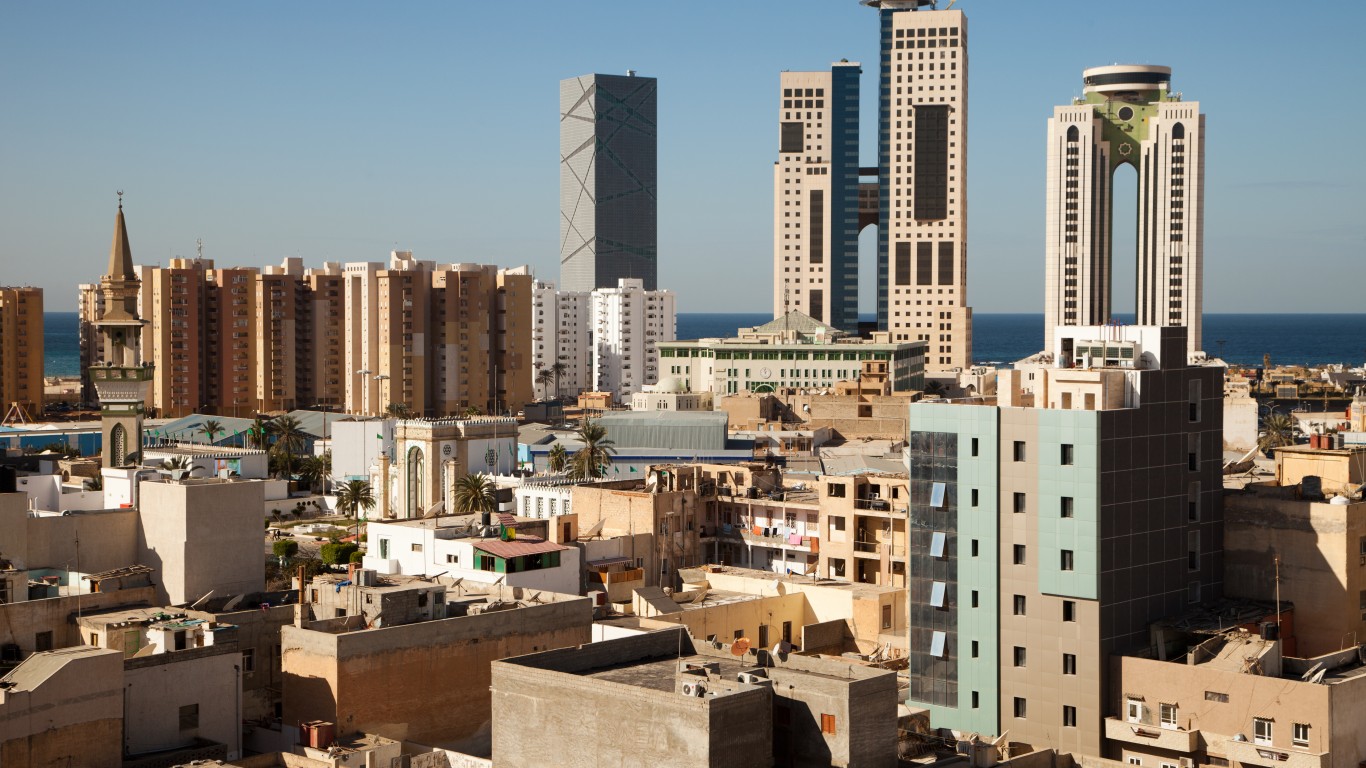
32. Libya
> CO2 emissions, metric tons per capita, 2019: 6.77
> CO2 emissions, metric tons per capita, 2010: 8.16 — #36 highest of 147 countries
> CO2 emissions per GDP, 2019: 0.40 — #19 highest of 148 countries
> Total GHG emissions, million metric tons, 2019: 114.87 — #37 highest of 87 countries
Libya was among the top 20 nations in CO2 emissions per GDP in 2019. The North African nation of 6.9 million has an energy plan in place in which it hopes renewables account for 10% of its energy mix by 2025. Electricity disruption remains a problem in Libya.
[in-text-ad-2]

31. Poland
> CO2 emissions, metric tons per capita, 2020: 6.98
> CO2 emissions, metric tons per capita, 2010: 7.98 — #37 highest of 147 countries
> CO2 emissions per GDP, 2020: 0.23 — #50 highest of 148 countries
> Total GHG emissions, million metric tons, 2020: 275.11 — #20 highest of 87 countries
Coal dominates the energy sources in Poland, one of the most polluted countries in Europe, and the industry is one of the largest employers in the nation of 38.4 million. Its energy policy calls for Poland to cut the share of coal and lignite power to 60% by 2030 from 80% in 2017. The country is planning to add its first nuclear power plant.

30. Mongolia
> CO2 emissions, metric tons per capita, 2019: 7.03
> CO2 emissions, metric tons per capita, 2010: 5.20 — #58 highest of 147 countries
> CO2 emissions per GDP, 2019: 0.58 — #5 highest of 148 countries
> Total GHG emissions, million metric tons, 2019: No data
This landlocked Asian nation between China and Russia is among the most polluted in the world. It had the fifth-highest total of CO2 emissions per GDP in 2019. Coal is the main source of energy for the nation of 3.3 million, but it is beginning to add renewables such as hydro, solar, and wind to its mix of energy sources.
[in-text-ad]
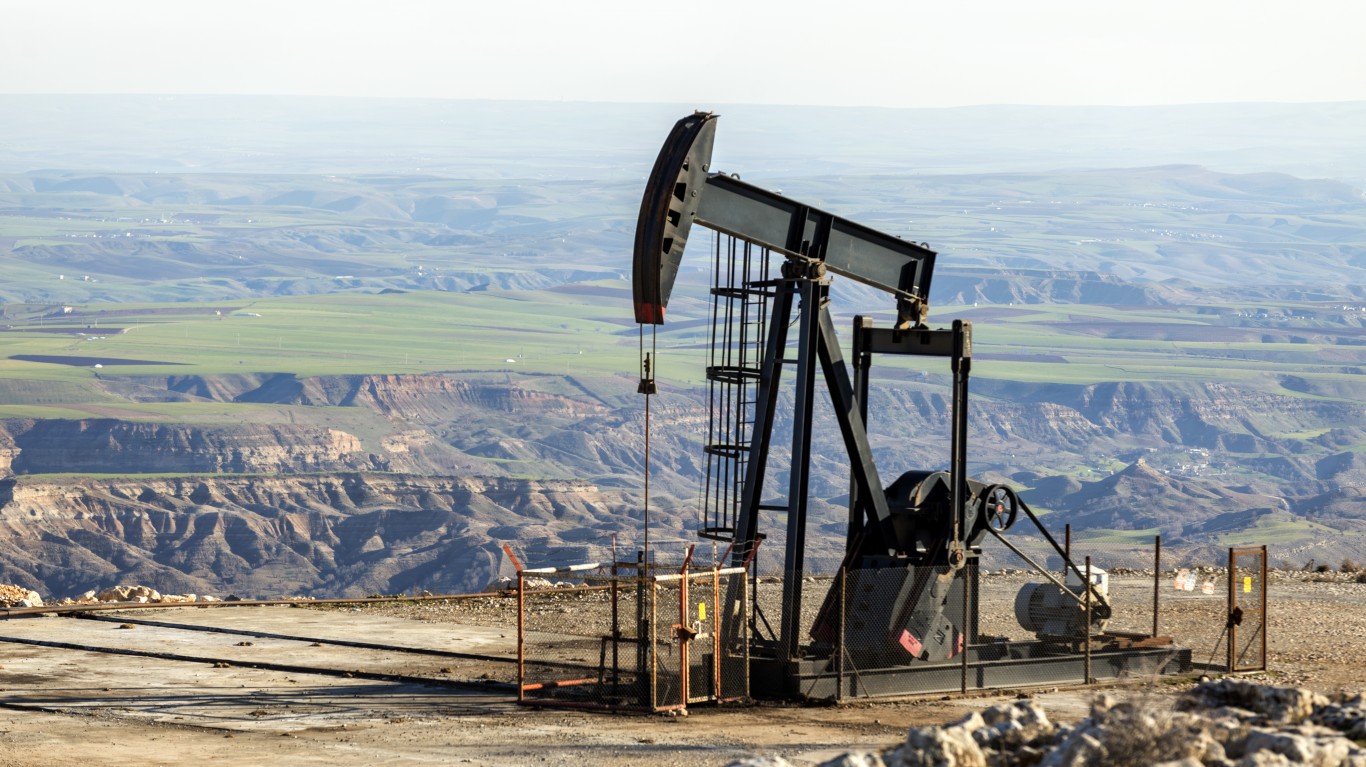
28. Iran
> CO2 emissions, metric tons per capita, 2019: 7.04
> CO2 emissions, metric tons per capita, 2010: 6.76 — #41 highest of 147 countries
> CO2 emissions per GDP, 2019: 0.52 — #7 highest of 148 countries
> Total GHG emissions, million metric tons, 2019: 778.10 — #6 highest of 87 countries
The Islamic Republic of Iran had the sixth-highest total in greenhouse-gas emissions and was seventh in CO2 emissions per GDP in 2019. The nation of 84 million people has legislation requiring the country to boost its share of renewables to 5% by the end of 2021.
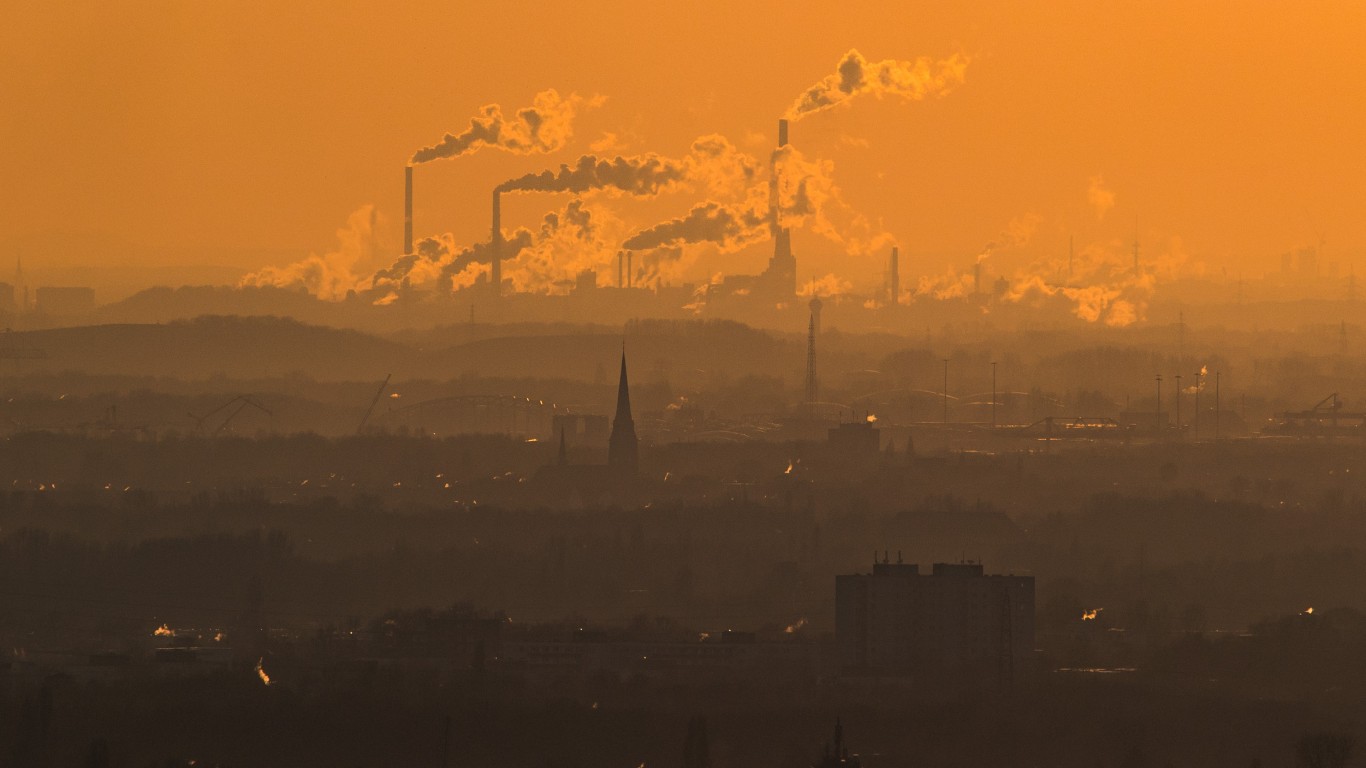
28. Germany
> CO2 emissions, metric tons per capita, 2020: 7.04
> CO2 emissions, metric tons per capita, 2010: 9.45 — #25 highest of 147 countries
> CO2 emissions per GDP, 2020: 0.15 — #60 lowest of 148 countries
> Total GHG emissions, million metric tons, 2020: 598.89 — #8 highest of 87 countries
Germany was eighth in the world in total greenhouse-gas emissions in 2019. Coal and nuclear energy sources are being phased out. Germany, a nation of 83.2 million people, plans to have half of its energy needs supplied by renewables by 2030. It also is boosting wind power and investing heavily in hydrogen.

27. China
> CO2 emissions, metric tons per capita, 2019: 7.07
> CO2 emissions, metric tons per capita, 2010: 5.85 — #51 highest of 147 countries
> CO2 emissions per GDP, 2019: 0.43 — #17 highest of 148 countries
> Total GHG emissions, million metric tons, 2019: 10618.71 — #1 highest of 87 countries
China’s energy needs are soaring, and the world’s most populous nation â 1.4 billion people â is utilizing a variety of energy sources. The International Energy Agency said China will account for 40% of the world’s renewable energy increase from 2019 to 2024. Over that period, China is predicted to account for half of the world’s solar-panel growth. Fossil fuels are still an important part of its economy, though, and China led the world in total greenhouse-gas emissions in 2019.
[in-text-ad-2]
26. Belgium
> CO2 emissions, metric tons per capita, 2020: 7.22
> CO2 emissions, metric tons per capita, 2010: 9.56 — #24 highest of 147 countries
> CO2 emissions per GDP, 2020: 0.16 — #68 lowest of 148 countries
> Total GHG emissions, million metric tons, 2019: No data
While Belgium still relies on fossil fuels, receiving its gas imports from The Netherlands, it is aggressively moving away from them. The nation of 11.5 million phased out coal-generated power in 2016 and the Western European country is considered a world leader in wind power.

25. South Africa
> CO2 emissions, metric tons per capita, 2019: 7.40
> CO2 emissions, metric tons per capita, 2010: 8.21 — #33 highest of 147 countries
> CO2 emissions per GDP, 2019: 0.61 — #3 highest of 148 countries
> Total GHG emissions, million metric tons, 2019: 477.10 — #12 highest of 87 countries
South Africa produced the world’s third-highest CO2 emission per GDP in 2019. The cost of energy is a paramount issue in the nation of 59.3 million. Coal is the main energy source, accounting for 70% of power generation capacity.
[in-text-ad]

24. Malaysia
> CO2 emissions, metric tons per capita, 2019: 7.41
> CO2 emissions, metric tons per capita, 2010: 6.73 — #42 highest of 147 countries
> CO2 emissions per GDP, 2019: 0.26 — #40 highest of 148 countries
> Total GHG emissions, million metric tons, 2019: 254.81 — #24 highest of 87 countries
The country of 32.4 million was among the top 25 nations on the list in total greenhouse-gas emissions in 2019. Air pollution from industry, cars, and forest fires is a major problem for the Asian nation. Its share of gas usage declined to 47% in 2015 from 67% in 2005 as it shifted to using more coal.

23. The Netherlands
> CO2 emissions, metric tons per capita, 2020: 7.72
> CO2 emissions, metric tons per capita, 2010: 10.28 — #23 highest of 147 countries
> CO2 emissions per GDP, 2020: 0.15 — #62 lowest of 148 countries
> Total GHG emissions, million metric tons, 2020: 136.55 — #36 highest of 87 countries
The Netherlands has launched an aggressive decoupling from fossil fuels, including a commitment to trim greenhouse-gas emissions by 49% by 2030 and building offshore wind power. The country aims to have 100% of its electricity needs come from renewables by 2050. For now, the nation of 17.4 million still depends on fossil fuels, however.
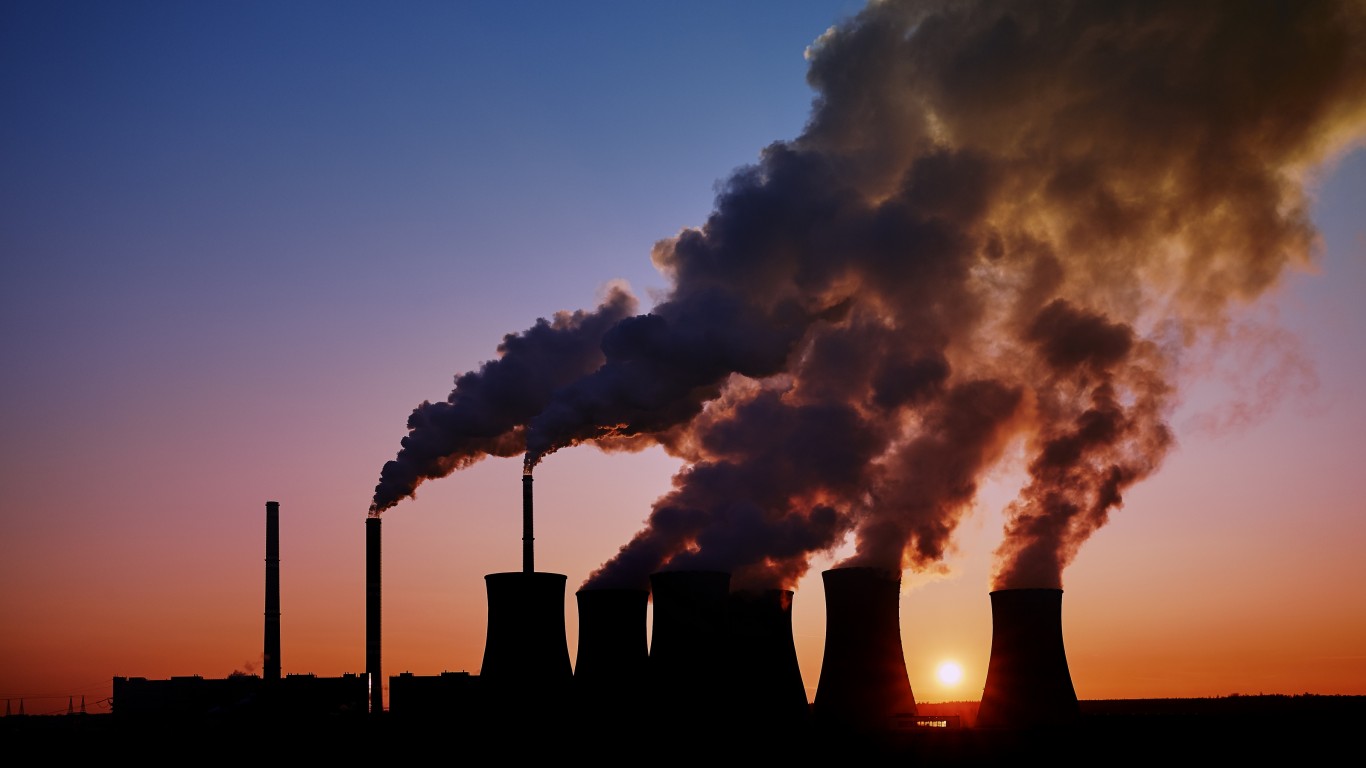
22. Czech Republic
> CO2 emissions, metric tons per capita, 2020: 7.88
> CO2 emissions, metric tons per capita, 2010: 10.53 — #22 highest of 147 countries
> CO2 emissions per GDP, 2020: 0.22 — #54 highest of 148 countries
> Total GHG emissions, million metric tons, 2019: No data
Coal is an essential source of energy for the nation of 10.7 million people and air pollution is a problem. Its car fleet is old and runs on diesel fuel. The IEA is working with the Czech Republic to wean it off of coal as a power and heating source. The nation established a state energy policy in 2015. The Czech Republic aims to slash energy consumption and expand nuclear power.
[in-text-ad-2]

21. Japan
> CO2 emissions, metric tons per capita, 2020: 8.15
> CO2 emissions, metric tons per capita, 2010: 8.84 — #28 highest of 147 countries
> CO2 emissions per GDP, 2020: 0.20 — #61 highest of 148 countries
> Total GHG emissions, million metric tons, 2020: 1038.20 — #5 highest of 87 countries
The world’s third-largest economy generated the fifth-highest level of total greenhouse-gas emissions in 2020. Greenhouse-gas emissions peaked in 2013 after the Fukushima accident led to the closure of nuclear plants and a surge in fossil-fuel use. Japan, with a population of 125 million, is trying to diversify its energy mix and is aiming for carbon neutrality by 2050.

20. Singapore
> CO2 emissions, metric tons per capita, 2019: 8.31
> CO2 emissions, metric tons per capita, 2010: 8.35 — #32 highest of 147 countries
> CO2 emissions per GDP, 2019: 0.09 — #22 lowest of 148 countries
> Total GHG emissions, million metric tons, 2019: No data
The city-state with 5.7 million people is the region’s second-biggest importer of gas and is aiming to be a trading hub for liquified natural gas. Singapore wants to boost its energy efficiency by 36% from 2005 levels by 2030.
[in-text-ad]

19. “Chinese Taipei” (Taiwan)
> CO2 emissions, metric tons per capita, 2020: 10.43
> CO2 emissions, metric tons per capita, 2010: 10.75 — #20 highest of 147 countries
> CO2 emissions per GDP, 2020: 0.22 — #56 highest of 148 countries
> Total GHG emissions, million metric tons, 2019: No data
The island technology powerhouse is working to diversify its energy sector. The nation of almost 24 million is seeking to produce 8% of its energy from renewable sources by 2025.

18. Russia
> CO2 emissions, metric tons per capita, 2020: 10.80
> CO2 emissions, metric tons per capita, 2010: 10.71 — #21 highest of 147 countries
> CO2 emissions per GDP, 2020: 0.43 — #18 highest of 148 countries
> Total GHG emissions, million metric tons, 2020: 2096.02 — #4 highest of 87 countries
The Russian Federation had the fourth-highest level of total greenhouse-gas emissions in 2020. Rich in fossil fuels, the nation of 144 million is utilizing its resources to build its economy and is exporting them to Europe. Russia aims to cut its energy-intensity level by 56% by 2030.

17. Korea
> CO2 emissions, metric tons per capita, 2020: 11.01
> CO2 emissions, metric tons per capita, 2010: 11.12 — #19 highest of 147 countries
> CO2 emissions per GDP, 2020: 0.27 — #39 highest of 148 countries
> Total GHG emissions, million metric tons, 2020: 578.60 — #11 highest of 87 countries
Korea, with one of the 12 largest economies in the world, had the 11th-highest level of total greenhouse-gas emissions in 2020. The country of about 52 million people is aiming to be carbon neutral by 2050 by phasing out coal and boosting its emerging hydrogen sector.
[in-text-ad-2]
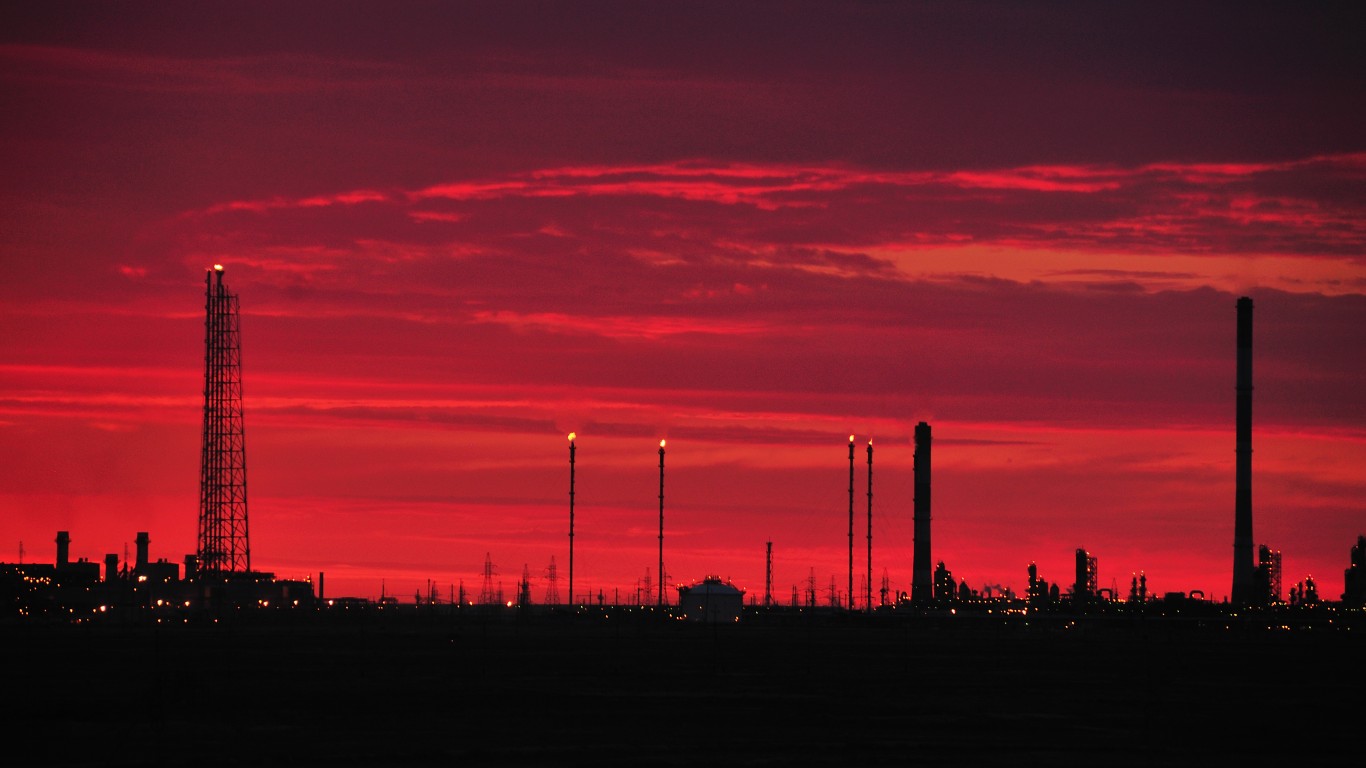
16. Kazakhstan
> CO2 emissions, metric tons per capita, 2019: 11.07
> CO2 emissions, metric tons per capita, 2010: 13.55 — #16 highest of 147 countries
> CO2 emissions per GDP, 2019: 0.44 — #16 highest of 148 countries
> Total GHG emissions, million metric tons, 2019: 235.30 — #25 highest of 87 countries
Kazakhstan is another Central Asian country with stores of fossil fuels. Its total oil production in 2017 increased 10.5%, and the landlocked nation of almost 18 million depends on Russia to export its oil to Europe. Kazakhstan also exports oil to China. Renewable energy sources are a small part of the energy sector but they are increasing.

15. Turkmenistan
> CO2 emissions, metric tons per capita, 2019: 11.65
> CO2 emissions, metric tons per capita, 2010: 11.19 — #18 highest of 147 countries
> CO2 emissions per GDP, 2019: 0.71 — #2 highest of 148 countries
> Total GHG emissions, million metric tons, 2019: 143.90 — #33 highest of 87 countries
A landlocked country in Central Asia, Turkmenistan pours subsidies into oil and gas industries to modernize its economy. None of its citizens pays for electricity, gas, or heat up to a certain level of use. The government is looking to cut subsidies and reduce domestic demand. The nation of about 6 million produced the second-highest level of CO2 emissions per GDP in 2019 of any country on the list.
[in-text-ad]
14. Luxembourg
> CO2 emissions, metric tons per capita, 2020: 11.86
> CO2 emissions, metric tons per capita, 2010: 20.99 — #3 highest of 147 countries
> CO2 emissions per GDP, 2020: 0.11 — #39 lowest of 148 countries
> Total GHG emissions, million metric tons, 2019: No data
The tiny European nation of about 600,000 people had the third-highest total of CO2 emissions per capita in 2010 of any country on the list. Luxembourg has embarked on an ambitious plan to trim greenhouse-gas emissions by up to 55% by 2030 compared with 2005, and is aiming to be carbon free by 2050.
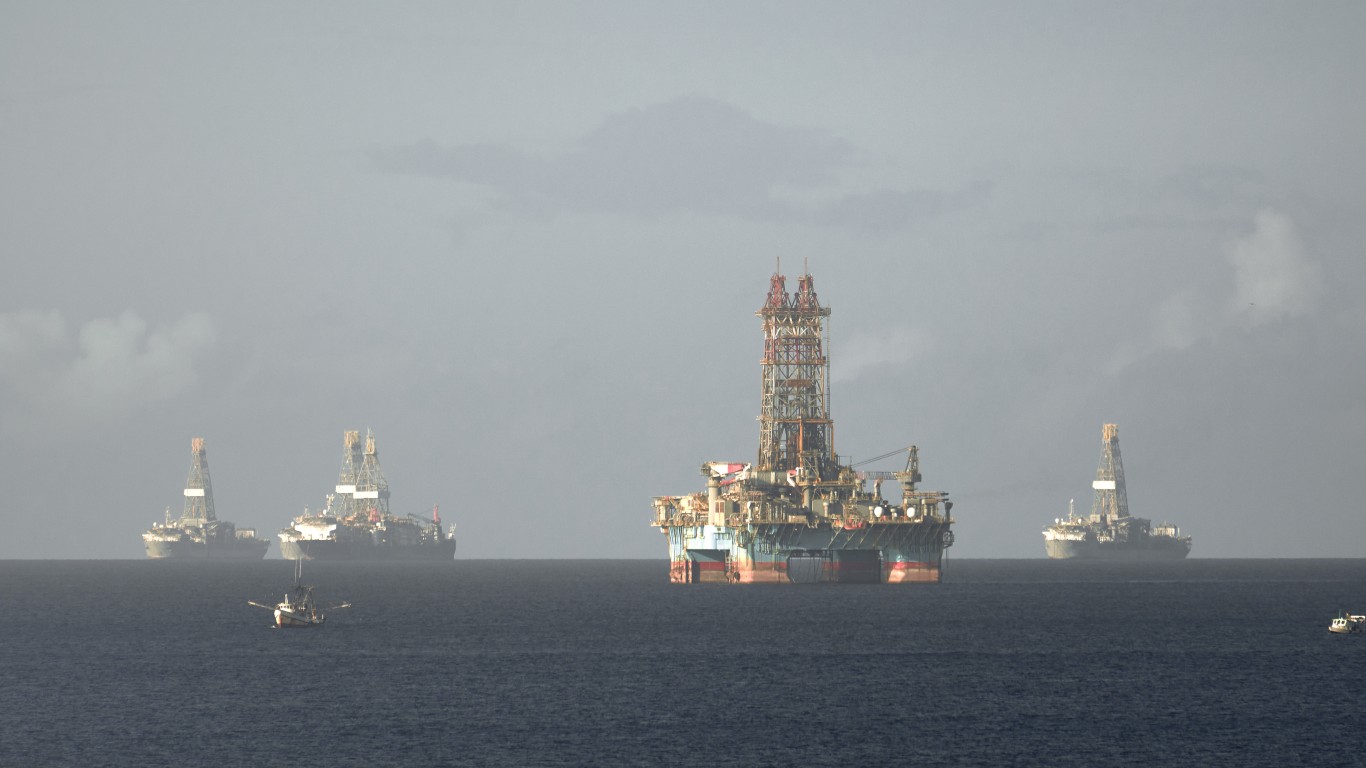
13. Trinidad and Tobago
> CO2 emissions, metric tons per capita, 2019: 11.90
> CO2 emissions, metric tons per capita, 2010: 15.81 — #10 highest of 147 countries
> CO2 emissions per GDP, 2019: 0.48 — #9 highest of 148 countries
> Total GHG emissions, million metric tons, 2019: 22.79 — #24 lowest of 87 countries
The Republic of Trinidad and Tobago has one of the largest natural-gas liquefaction facilities in the Western Hemisphere. The island nation of 1.4 million generated the ninth-highest level of CO2 emissions per GDP in 2019 of any country on the list.
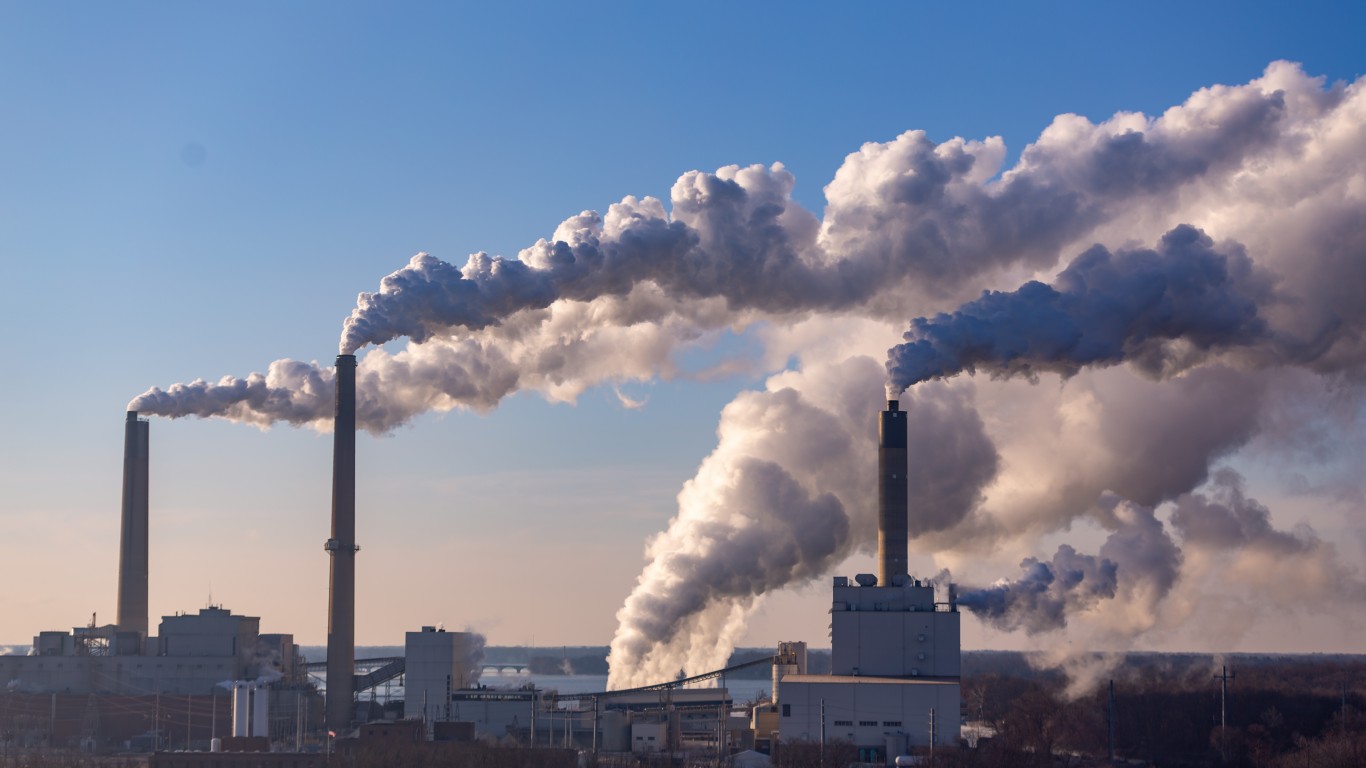
12. United States
> CO2 emissions, metric tons per capita, 2020: 12.98
> CO2 emissions, metric tons per capita, 2010: 17.28 — #9 highest of 147 countries
> CO2 emissions per GDP, 2020: 0.22 — #53 highest of 148 countries
> Total GHG emissions, million metric tons, 2020: 4736.52 — #2 highest of 87 countries
The United States, with the world’s largest economy, produced the second-highest amount of greenhouse-gas emissions in 2020. The nation of 330 million has reduced its use of coal, natural gas, and petroleum (use of the three dropped 9% last year compared to 2019) and the use of solar and wind power is increasing, helping to initiate a transformation of America’s energy landscape. Total CO2 emissions have plunged almost 11% since 1990.
[in-text-ad-2]
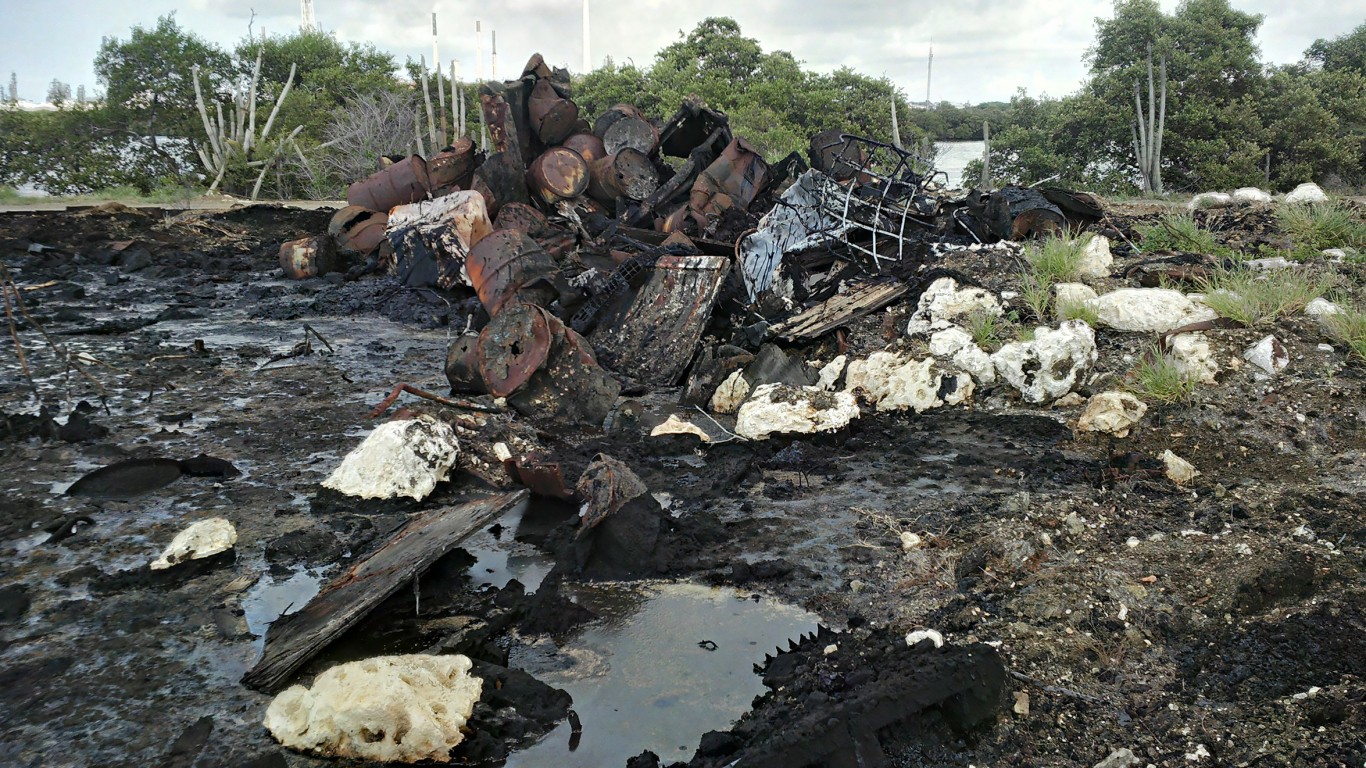
11. Curaçao
> CO2 emissions, metric tons per capita, 2019: 13.74
> CO2 emissions, metric tons per capita, 2010: 19.12 — #5 highest of 147 countries
> CO2 emissions per GDP, 2019: 1.31 — #1 highest of 148 countries
> Total GHG emissions, million metric tons, 2019: No data
The Caribbean island nation of Curaçao may be one of the least populous countries on the list with just over 100,000 people, but it had the highest CO2 emissions per GDP in 2019. Even so, total CO2 emissions have fallen more than 66% since 2007. Curaçao imports all of its energy and is dependent on petroleum. Its goal is to achieve 50% renewable energy by 2030.

10. Canada
> CO2 emissions, metric tons per capita, 2020: 13.77
> CO2 emissions, metric tons per capita, 2010: 15.47 — #11 highest of 147 countries
> CO2 emissions per GDP, 2020: 0.32 — #27 highest of 148 countries
> Total GHG emissions, million metric tons, 2020: 587.20 — #9 highest of 87 countries
Canada, with about 38 million people, had the ninth-highest total greenhouse-gas emissions on the list in 2020. The nation has vowed to cut CO2 emissions by 30% below 2005 levels by 2030 and be at zero by 2050.
[in-text-ad]

9. Oman
> CO2 emissions, metric tons per capita, 2019: 13.87
> CO2 emissions, metric tons per capita, 2010: 13.96 — #14 highest of 147 countries
> CO2 emissions per GDP, 2019: 0.48 — #9 highest of 148 countries
> Total GHG emissions, million metric tons, 2019: 92.34 — #41 highest of 87 countries
The Sultanate of Oman, on the southeastern coast of the Arabian Peninsula, relies on natural gas and oil that it produces and it is a major exporter of those fossil fuels. The country of 5.1 million people has embarked on a solar-power initiative for private use.

8. Saudi Arabia
> CO2 emissions, metric tons per capita, 2019: 14.45
> CO2 emissions, metric tons per capita, 2010: 15.25 — #12 highest of 147 countries
> CO2 emissions per GDP, 2019: 0.31 — #31 highest of 148 countries
> Total GHG emissions, million metric tons, 2019: 581.96 — #10 highest of 87 countries
Saudi Arabia is synonymous with oil production and is one of the leaders of OPEC, the Organization of the Petroleum Exporting Countries. Total CO2 emissions in the kingdom of almost 35 million people have been trending downward since 2015. Still, it had the 10th-highest total greenhouse-gas emissions of any country in 2019. Saudi Arabia has been implementing more energy-efficient processes and now requires new construction to have insulation.

7. Australia
> CO2 emissions, metric tons per capita, 2020: 14.63
> CO2 emissions, metric tons per capita, 2010: 17.40 — #8 highest of 147 countries
> CO2 emissions per GDP, 2020: 0.32 — #27 highest of 148 countries
> Total GHG emissions, million metric tons, 2020: 424.40 — #15 highest of 87 countries
Total CO2 emissions have been trending downward in Australia, beginning in 2009. The government is working to integrate renewables into the energy mix for the nation of 25.7 million people.
[in-text-ad-2]

6. Brunei Darussalam
> CO2 emissions, metric tons per capita, 2019: 15.22
> CO2 emissions, metric tons per capita, 2010: 17.64 — #7 highest of 147 countries
> CO2 emissions per GDP, 2019: 0.25 — #42 highest of 148 countries
> Total GHG emissions, million metric tons, 2019: 8.43 — #10 lowest of 87 countries
The small nation on the island of Borneo in Southeast Asia, with fewer than 500,000 people, adopted a plan in 2014 to reach 10% of its energy needs through renewables by 2035. It had the seventh-highest total of CO2 emissions, metric tons per capita, in 2010.

5. United Arab Emirates
> CO2 emissions, metric tons per capita, 2019: 18.22
> CO2 emissions, metric tons per capita, 2010: 18.09 — #6 highest of 147 countries
> CO2 emissions per GDP, 2019: 0.27 — #37 highest of 148 countries
> Total GHG emissions, million metric tons, 2019: 208.52 — #27 highest of 87 countries
The United Arab Emirates is on the eastern end of the Arabian Peninsula, and like other nations in that part of Western Asia, the country of nearly 10 million produces most of its energy from oil and natural gas. Since 2014, it has begun generating solar power.
[in-text-ad]

4. Bahrain
> CO2 emissions, metric tons per capita, 2019: 19.86
> CO2 emissions, metric tons per capita, 2010: 20.58 — #4 highest of 147 countries
> CO2 emissions per GDP, 2019: 0.47 — #14 highest of 148 countries
> Total GHG emissions, million metric tons, 2019: 37.57 — #37 lowest of 87 countries
The island kingdom on the Persian Gulf is a major producer and exporter of oil, natural gas, and petroleum products. The nation of 1.7 million had the fourth-highest total of CO2 emissions, in metric tons per capita, in 2010.
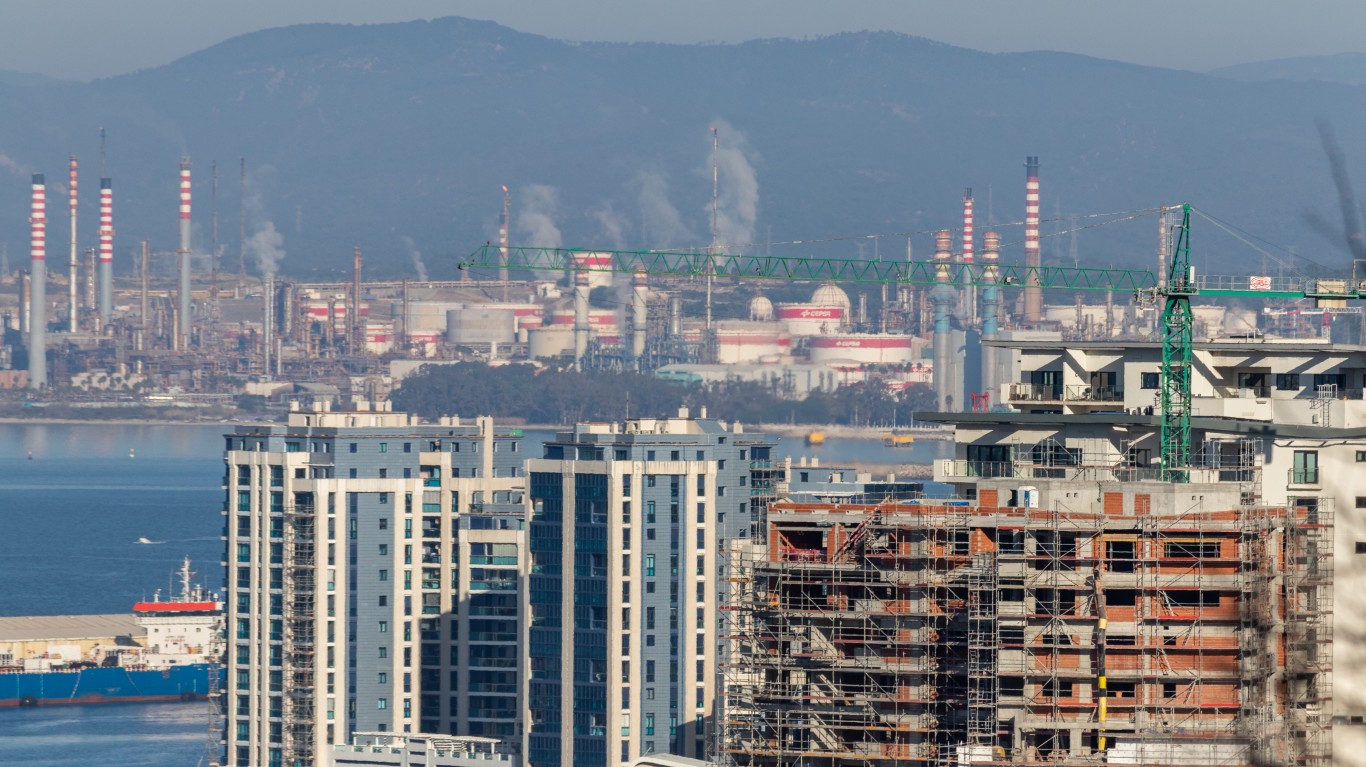
3. Gibraltar
> CO2 emissions, metric tons per capita, 2019: 21.08
> CO2 emissions, metric tons per capita, 2010: 13.95 — #15 highest of 147 countries
> CO2 emissions per GDP, 2019: 0.55 — #6 highest of 148 countries
> Total GHG emissions, million metric tons, 2019: No data
Located at the southern tip of the Iberian Peninsula, the British Overseas Territory of Gibraltar, with a population of about 34,000, had the sixth-highest amount of CO2 emissions per GDP in 2019. Gibraltar published its first Climate Change Act in 2019. Under the legislation, Gibraltar plans to slash CO2 emissions to zero by 2045.

2. Kuwait
> CO2 emissions, metric tons per capita, 2019: 21.26
> CO2 emissions, metric tons per capita, 2010: 25.78 — #2 highest of 147 countries
> CO2 emissions per GDP, 2019: 0.50 — #8 highest of 148 countries
> Total GHG emissions, million metric tons, 2019: 113.74 — #38 highest of 87 countries
Kuwait, a wealthy country on the Arabian Peninsula, is completely reliant on fossil fuels, and it expects to triple its energy demand by 2030. The nation of 4.3 million people is varying its energy sources and plans to boost renewables to 15% of its energy requirements by 2030.
[in-text-ad-2]

1. Qatar
> CO2 emissions, metric tons per capita, 2019: 30.68
> CO2 emissions, metric tons per capita, 2010: 29.91 — #1 highest of 147 countries
> CO2 emissions per GDP, 2019: 0.35 — #23 highest of 148 countries
> Total GHG emissions, million metric tons, 2019: 109.67 — #39 highest of 87 countries
Qatar, on the northeastern coast of the Arabian Peninsula, had the highest amount of CO2 emissions in metric tons per capita of any nation on this list in 2019 and 2020. Energy production, total primary energy supply, electricity final consumption, and total CO2 emissions have all soared by at least 533% since 1990 in the nation of about 2.9 million people.
Credit card companies are handing out rewards and benefits to win the best customers. A good cash back card can be worth thousands of dollars a year in free money, not to mention other perks like travel, insurance, and access to fancy lounges. See our top picks for the best credit cards today. You won’t want to miss some of these offers.
Flywheel Publishing has partnered with CardRatings for our coverage of credit card products. Flywheel Publishing and CardRatings may receive a commission from card issuers.
Thank you for reading! Have some feedback for us?
Contact the 24/7 Wall St. editorial team.

 24/7 Wall St.
24/7 Wall St.



